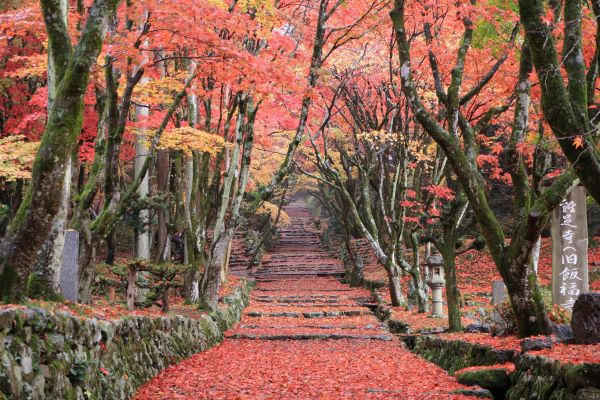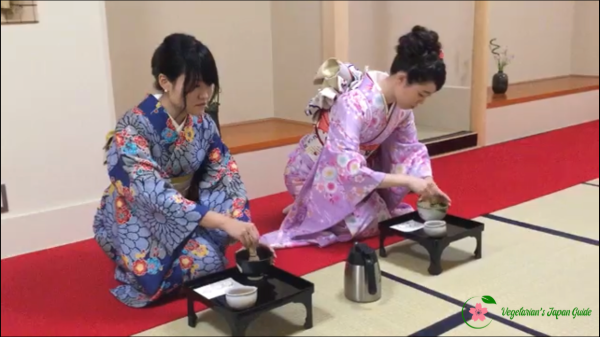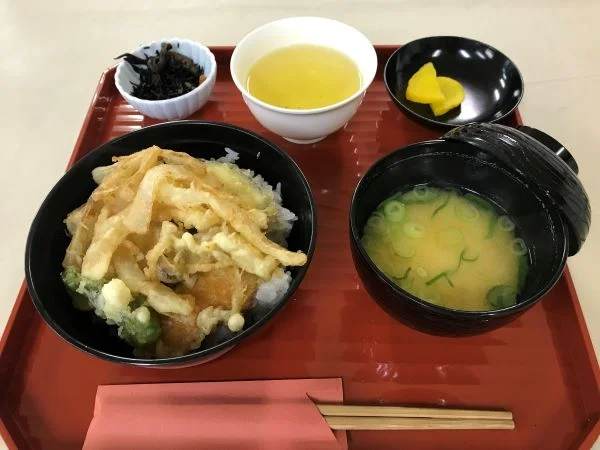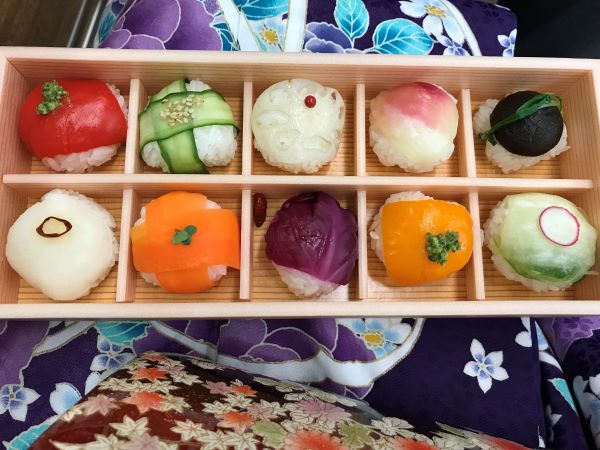Chikubu Island (竹生島), floating on the northern Lake Biwa, has been a sacred island since ancient times. Together with the Benzaiten in Enoshima (江ノ島) and Miyajima (宮島), the Benzaiten enshrined on the island are together known as the Three Great Benzaiten in Japan. Also, the Hōngon-ji Temple (宝厳寺) on the island is the 30th temple on the 33 Saigoku Kannon Pilgrimage. A couple of the temple buildings were originally a part of Osaka Castle and Toyotomi Hideyoshi’s boat Nihonmaru.
Lake Biwa, Japan’s largest lake, is said to have been created about 4 million years ago. The lake, with many myths, is the third oldest in the world. However, the name Biwa was only given to it around 300 years ago.
Chikubu Island, the second biggest island in Lake Biwa, is a National Place of Scenery Beauty itself, and the view of the island floating on the lake was chosen to be one of the Eight Views of Lake Biwa (琵琶湖八景).
The view called ‘Sinryoku Chikubushima no Chinei’ (深緑 竹生島の沈影) describes the scenery of Chikubu Island, which is covered by abundant dark green greenery reflecting on the water’s surface.
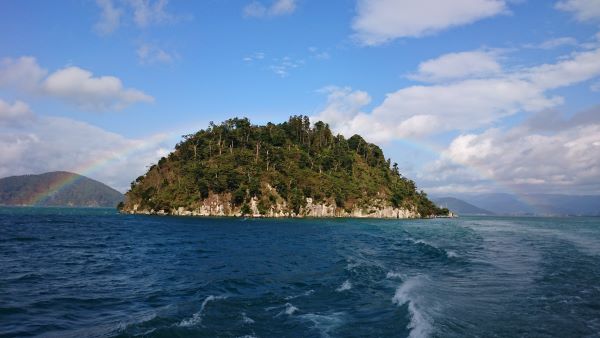
Explore Chikubu Island and Nagahama City With a Guided Tour
If you prefer a guide to introduce you to the charms of Chikubu Island, how about joining the below tour?
How to Get to Chikubu Island
As no bridge has been built to connect the island with Japan’s main island, the most viable way to set foot on the island where god lives is by ferry.
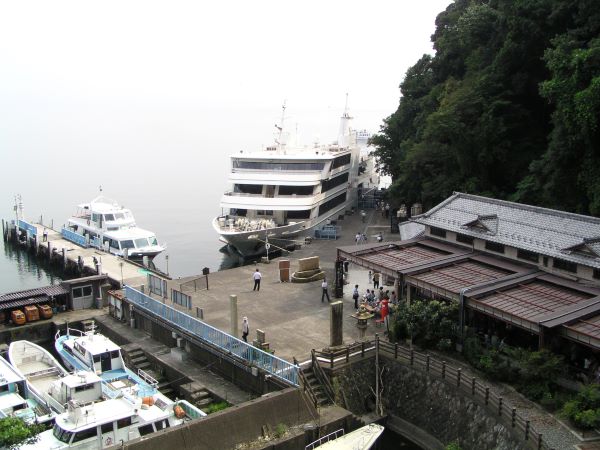
Around Lake Biwa, regular ferries depart from Nagahama Port (長浜港), close to Nagahama Castle Historical Museum (長浜城歴史博物館), Imazu Port (今津港), or Hikone Port (彦根港), close to Hikone Castle (彦根城).
The most recommended way to get to the island is to take a ferry operated by Biwako Kisen (琶湖汽船) from Nagahama Port (although the most expensive way). This route will give you a better view of Mt. Ibuki (伊吹山) and Mt. Kanaguso (金糞岳).
For more details about the cruise, please refer to Biwako Kisen’s website HERE.
If you are heading to the island from Hikone Port, refer to the timetable HERE. You can translate the webpage with Google Chrome’s translation function at the right of the address bar.
- The first and the last column under Chikubu Island represent the arrival and departure times.
- The middle column is the time you will have on the island if you want to take the same ship back to Hikone Port (it is usually more than enough for you to explore Chikubu Island fully).
Tip: Purchase your ferry ticket through kkday to save 270 yen!
The Violent Legend of Chikubu Island
Why is it important to see those two particular mountains we mentioned above? It is to do with the legend of the formation of Chikubu Island.
Once upon a time, the god of Mt. Ibuki and the god of Mt. Kanaguso were competing over who was taller. Losing the competition, the god of Mt. Ibuki was so furious that he cut off the head of Mt. Kanaguso’s god Σ(゚Д゚).
The head fell into Lake Biwa and became Chikubu Island. The Tsukubusuma Shrine (都久夫須麻神社) was later built to enshrine Azaihime no Mikoto (浅井姫命), the god of the then Mt. Azai (the current Mt. Kanaguso).
So when you cruise through Lake Biwa, see which mountain you think is taller. As you approach Chichiku Island, we are sure you will have a somewhat different mood knowing the legend.
Upon Arrival on Chikubu Island

From Nagahama Port, after enjoying a 30-minute cruise, The ferry will finally stop at Chikubu Island Port (竹生島港). Soon after you set foot on the island, staircases leading to Hōngon-ji and Tsukubusuma Shrine will be in front of you, waiting for you to climb up.
Remember to get your entry ticket to Chikubu Island from one of the vending machines at the port. The ticket provides admission to both the temple and the shrine.
- Adults: 600 yen
- Elementary school students: 300 yen
- Pre-school children: Free
Passing through the first torii gate that you encounter on the island, if you head right, you will soon arrive at Tsukubusuma Shrine (都久夫須麻神社). But let’s head straight first for Hōngon-ji Temple.
Important: There is no one living on the island. So before you stroll off, remember to check for the ferry’s departure time that you are planning to take. Keeping in mind the last ferry’s departure time will also be handy just in case you find yourself needing more time to explore the island.
Hōngon-ji Temple (宝厳寺)
There are 165 stone staircases to reach the main worship hall of Hōngon-ji. As you walk up the stairs, check out the characters curved at the right end of each staircase.
All building materials were brought to the island when the temple was built. Shipped by small wooden boats that could be easily overturned by waves caused by strong winds, the task was life-risking and required a lot of effort. The temple could only be completed with people’s strong desire for a place to offer their prayers.
Thus, the names and addresses of those involved were carved into the staircases. This is why the staircases are now known as the ‘Staircases of Prayers’ (祈りの階段).
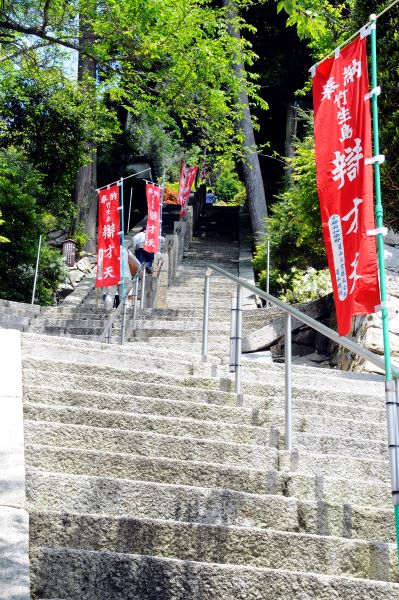
The Founding of Hōngon-ji
The main image of Hōngon-ji is Benzaiten, the goddess of wealth, music, eloquence, and water. The temple’s legend goes that in 724, Emperor Shōmu (聖武天皇) dreamed of the goddess of the sun, Amaterasu Ōmikami (天照皇大神). In the dream, the god told him about a small island in Lake Biwa. The island is the sanctuary of Benzaiten. If he builds a temple on the island, the country will rejoice in peace and prosperity.
Taking the dream seriously, Emperor Shōmu requested the revered monk of the time – Gyōki (行基), to erect Hōngon-ji.
Among the temples with one of the Three Great Benzaiten in Japan enshrined, Hōngon-ji is the oldest. People thus referred to the Benzaiten here as “Dai-benzaiten (大弁才天)”, with the “dai” meaning great.
Benzaiten is originally a Hindu god named Saraswati, who is also a guardian god of Buddhism. When Buddhism was passed to Japan, Saraswati became Benzaiten. In Japanese mythology, Benzaiten is also one of the Seven Gods of Fortune (七福神).
Hōngon-ji’s Hon-dō
The statue of Benzaiten in Hōngon-ji’s main worship hall was offered by the second lord of the Azai clan – Azai Hisamasa (浅井久政) and his mother, in 1556. As it is only shown to the public once every 60 years, if you are interested in meeting him, come to Chikubu Island in 2037.

The two sides of the main worship hall are guarded by Uga-benzaiten (宇賀弁才天). If you look at the statue closely, you will notice the god is “wearing” a torii gate on its head. Behind the torii gate is a Ugajin (宇賀神), who looks after harvest and fertility!
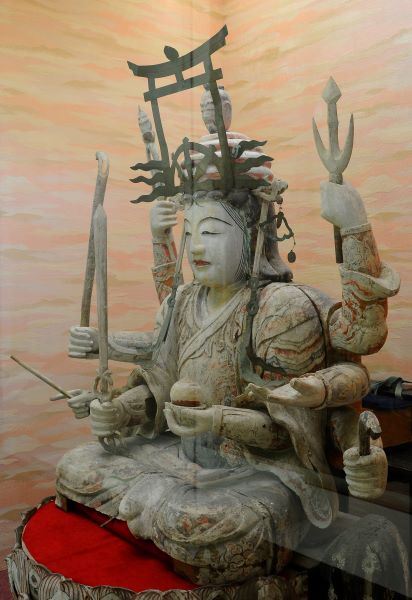
Another unusual thing that will catch your attention is the hundreds of Daruma dolls placed inside the worship hall. These little red dolls have Benzaiten drowned on them. What they are holding in their hands is a Japanese lute.
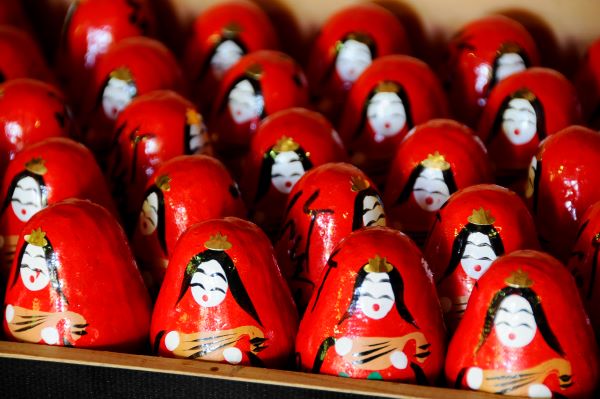
What are they there for?
They are holding the wishes of pilgrims inside them. The dolls are called Benzaiten-sama no Shiawase Negai Daruma (弁天様の幸せ願いダルマ), which means “Benzaitten’s daruma dolls for wishing happiness”. If you purchase one of these handmade dolls, write your wishes on a piece of paper and put it inside the doll before placing it in the worship hall.
If you want to bring back a Daruma doll, they also sell the dolls as charms for you to hang on the zip of your bag.
Zuishōsui Water (瑞祥水)
Before you go down the stairs and head left to Karamon Gate, stop by a well that goes as deep as 230 meters!
The well is relatively new and was only completed in 2002. The reason for the construction of the well all started with the abnormal breeding of cormorants in 1987. The activities of the birds caused big damage to the ecological system, making clean water hard to obtain.
What saved the island from the crisis was a dream involving the temple’s main image, Benzaiten.
One night, the head priest had a dream. In the dream, her solution was to dig a well where the well is located today. Although there were no successful prior cases where the water source was discovered by digging down in the ground on an island like Chikubu, fresh streams were discovered after around a year of digging, just like what Benzaiten had said in the dream!
The water coming out of the well is regarded as Zuishōsui. It is drinkable and has a reputation for its deliciousness. Some even reported regaining health after continuous consumption!
Hōngon-ji Karamon Gate (宝厳寺唐門)
Heading down east of the main worship hall, you will be impressed by a splendid Chinese cusped gable roof. This Momoyama-style roof is the entrance to the Kannon-dō Hall and is a National Treasure.

The gate was gifted in 1603 to the temple by Toyotomi Hideyoshi’s son, Toyotomi Hideyori (豊臣秀頼). Before the gate was transported to Hōngon-ji, it was the gate to his father’s Mausoleum (豊国廟) in Kyoto.
However, it was originally the gate in front of Osaka castle’s Gokurakubashi Bridge (極楽橋) until 1596. After Toyotomi Hideyoshi passed away, it was moved to the mausoleum in 1600.
You might have been to Osaka Castle, but the castle you saw wasn’t the original luxurious castle that Toyotomi Hideyoshi built. The only building left in the world that is a part of the original Osaka castle is this Karamon Gate!
The Hōngon-ji Karamon is covered by black lacquer with golden decorations and colorful carvings such as lions, pine, rabbits, and peonies. If you check it out carefully, there are paulownias at the back of this peony (=゚ω゚)ノ.
The Thousand-hands and Thousand-eyed Kannon Bodhisattva statue in Kannon-dō represents the kindness of the Kannon Bodhisattva. With so many of us seeking his help, he has to have thousands of hands and eyes to help every single one of us.
Together with the Benzaiten in the main worship hall, the Kannon Bodhisattva is also only exhibited to the public once every 60 years.
Boat Corridor (舟廊下)
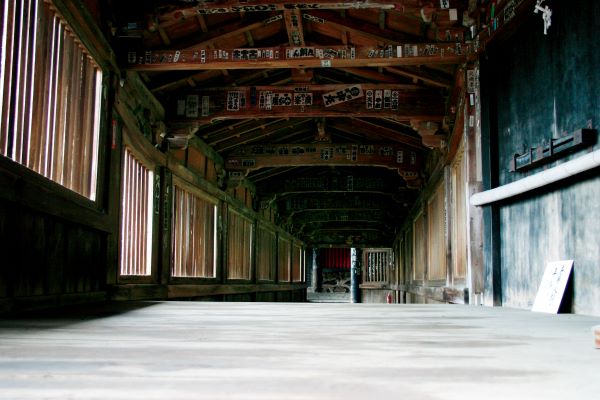
Passing the Hōngon-ji Karamon Gate, what connects you to Tsukubusuma Shrine (都久夫須麻神社) is a 30-meter-long boat corridor.
The corridor doesn’t really look like a traditional boat. Where it got its name from is due to its building materials being from a ship. And this is no ordinary ship we are talking about. It is the Nihon-maru (日本丸) that Toyotomi Hideyoshi boarded on his way to invade Korea.
After you get to the other end of the corridor, take a look at it from the outside. The Important National Cultural Property is built on a slope in the same Butai-dzukuri style (舞台造) as Kiyomizu-dera’s main worship hall.
Tsukubusuma Shrine (都久夫須麻神社)
Tsukubusuma Shrine is located beyond Kannon-dō. The main worship hall is a National Treasure and was gifted by Toyotomi Hideyori. It is another building on the island that was relocated from a castle in the Kansai region. This time, it is from Fushimi Momoyama Castle (伏見桃山城).
If you are wondering why Hideyori wanted to relocate buildings that were deeply connected with his father, the answer is quite political.
After Hideyoshi passed away, Tokugawa Ieyasu tried his best to reduce the influence of the Toyotomi clan. To save his father’s legacy, Hideyori ordered him to relocate architecture related to his father away from the political center.

Remember the legend of Chikubu Island that we mentioned earlier? This is where the god who was killed in the legend is enshrined in.
Since its establishment, the shrine has suffered from several fire hazards. In the Sengoku period, to restore the buildings of the shrine, Higurashi-goden (日暮御殿) from Fushimi Castle was relocated and reconstructed on Chikubu Island.
Ryūjin Haijo (竜神拝所) and Kawarake-nage (かわらけ投げ)
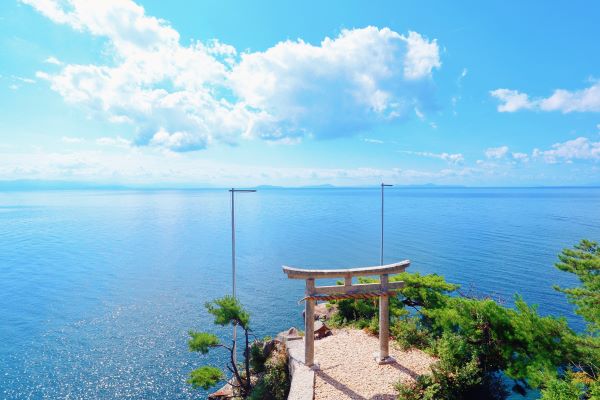
Near the lakeshore opposite the main worship hall is a place of worship for the eight dragon gods protecting Buddhism.
Not only is the scenery the most magnificent on the entire Chikubu Island, but it is also a famous spot for fulfilling your wishes!
The simple ritual is known as Kawarake-nage. After you purchase a set of plates (come with two plates), write your wishes on one of the earthenware plates and your name on the other. Then try to throw it in a way so that it flies through the stone torii gate. If you manage to do it, it is said that your wish written on the earthenware will come true!
As there is quite a distance between the Ryūjin Haijo and the torii gate, you will need enough strength for the plates to fly that far.
Chikubu Island’s Delicious Speciality – Benten Imomochi (弁天芋餅)
A good souvenir to bring back home from Chikubu Island is the Benten Imomochi.
Although the main ingredient is potato, the dessert is made in a way that you can’t really tell that what you are eating is mainly potatoes (´▽`*).
Discover Other Exciting Attractions in Nagahama City
Nagahama, the second biggest city in Shiga Prefecture, is rich in history and nature. Toyotomi Hideyoshi’s success in becoming the leader of Japan in the second half of the 16th century is said to have started from here.
Apart from the cultural and historical attractions, the city will also excite shopaholics and figurine manias!
For more information, please refer to our article on Nagahama (=゚ω゚)ノ.


